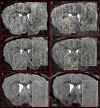In Vivo Detection of Amyloid Plaques by Gadolinium-Stained MRI Can Be Used to Demonstrate the Efficacy of an Anti-amyloid Immunotherapy
- PMID: 27047372
- PMCID: PMC4802995
- DOI: 10.3389/fnagi.2016.00055
In Vivo Detection of Amyloid Plaques by Gadolinium-Stained MRI Can Be Used to Demonstrate the Efficacy of an Anti-amyloid Immunotherapy
Abstract
Extracellular deposition of β amyloid plaques is an early event associated to Alzheimer's disease. Here, we have used in vivo gadolinium-stained high resolution (29(∗)29(∗)117 μm(3)) magnetic resonance imaging (MRI) to follow-up in a longitudinal way individual amyloid plaques in APP/PS1 mice and evaluate the efficacy of a new immunotherapy (SAR255952) directed against protofibrillar and fibrillary forms of Aβ. APP/PS1 mice were treated for 5 months between the age of 3.5 and 8.5 months. SAR255952 reduced amyloid load in 8.5-months-old animals, but not in 5.5-months animals compared to mice treated with a control antibody (DM4). Histological evaluation confirmed the reduction of amyloid load and revealed a lower density of amyloid plaques in 8.5-months SAR255952-treated animals. The longitudinal follow-up of individual amyloid plaques by MRI revealed that plaques that were visible at 5.5 months were still visible at 8.5 months in both SAR255952 and DM4-treated mice. This suggests that the amyloid load reduction induced by SAR255952 is related to a slowing down in the formation of new plaques rather than to the clearance of already formed plaques.
Keywords: Alzheimer; MRI; amyloid; gadolinium; immunotherapy.
Figures



References
-
- Adolfsson O., Pihlgren M., Toni N., Varisco Y., Buccarello A. L., Antoniello K., et al. (2012). An effector-reduced anti-beta-amyloid (Abeta) antibody with unique abeta binding properties promotes neuroprotection and glial engulfment of Abeta. J. Neurosci. 32 9677–9689. 10.1523/JNEUROSCI.4742-11.2012 - DOI - PMC - PubMed
-
- Anzalone N., Scarabino T., Venturi C., Cristaudo C., Tartaro A., Scotti G., et al. (2013). Cerebral neoplastic enhancing lesions: multicenter, randomized, crossover intraindividual comparison between gadobutrol (1.0M) and gadoterate meglumine (0.5M) at 0.1 mmol Gd/kg body weight in a clinical setting. Eur. J. Radiol. 82 139–145. 10.1016/j.ejrad.2011.07.005 - DOI - PubMed
Grants and funding
LinkOut - more resources
Full Text Sources
Other Literature Sources

